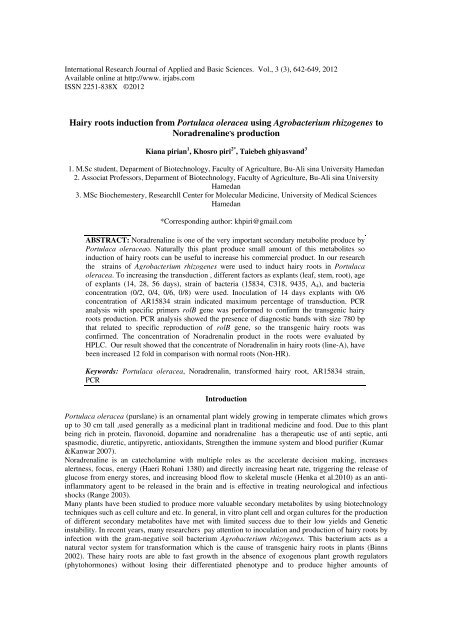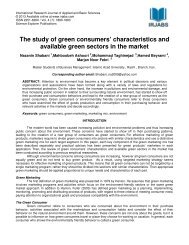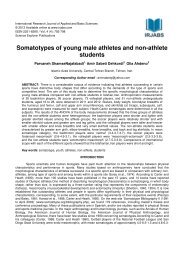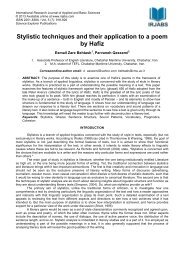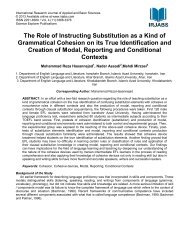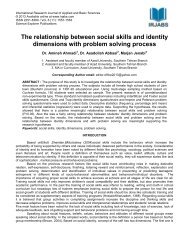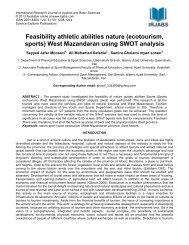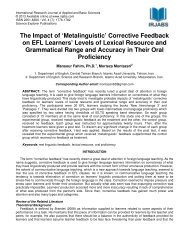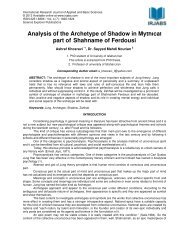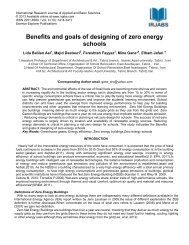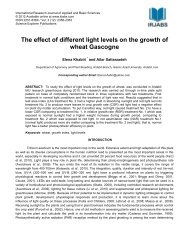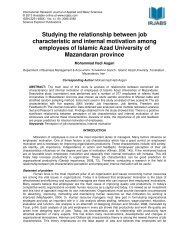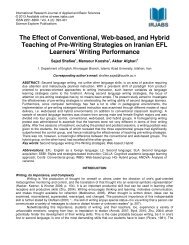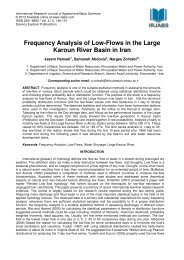Hairy roots induction from Portulaca oleracea using ... - irjabs.com
Hairy roots induction from Portulaca oleracea using ... - irjabs.com
Hairy roots induction from Portulaca oleracea using ... - irjabs.com
Create successful ePaper yourself
Turn your PDF publications into a flip-book with our unique Google optimized e-Paper software.
International Research Journal of Applied and Basic Sciences. Vol., 3 (3), 642-649, 2012Available online at http://www. <strong>irjabs</strong>.<strong>com</strong>ISSN 2251-838X ©2012<strong>Hairy</strong> <strong>roots</strong> <strong>induction</strong> <strong>from</strong> <strong>Portulaca</strong> <strong>oleracea</strong> <strong>using</strong> Agrobacterium rhizogenes toNoradrenaline , s productionKiana pirian 1 , Khosro piri 2* , Taiebeh ghiyasvand 31. M.Sc student, Deparment of Biotechnology, Faculty of Agriculture, Bu-Ali sina University Hamedan2. Associat Professors, Deparment of Biotechnology, Faculty of Agriculture, Bu-Ali sina UniversityHamedan3. MSc Biochemestery, Researchll Center for Molecular Medicine, University of Medical SciencesHamedan*Corresponding author: khpiri@gmail.<strong>com</strong>ABSTRACT: Noradrenaline is one of the very important secondary metabolite produce by<strong>Portulaca</strong> <strong>oleracea</strong>o. Naturally this plant produce small amount of this metabolites so<strong>induction</strong> of hairy <strong>roots</strong> can be useful to increase his <strong>com</strong>mercial product. In our researchthe strains of Agrobacterium rhizogenes were used to induct hairy <strong>roots</strong> in <strong>Portulaca</strong><strong>oleracea</strong>. To increasing the transduction , different factors as explants (leaf, stem, root), ageof explants (14, 28, 56 days), strain of bacteria (15834, C318, 9435, A 4 ), and bacteriaconcentration (0/2, 0/4, 0/6, 0/8) were used. Inoculation of 14 days explants with 0/6concentration of AR15834 strain indicated maximum percentage of transduction. PCRanalysis with specific primers rolB gene was performed to confirm the transgenic hairy<strong>roots</strong> production. PCR analysis showed the presence of diagnostic bands with size 780 bpthat related to specific reproduction of rolB gene, so the transgenic hairy <strong>roots</strong> wasconfirmed. The concentration of Noradrenalin product in the <strong>roots</strong> were evaluated byHPLC. Our result showed that the concentrate of Noradrenalin in hairy <strong>roots</strong> (line-A), havebeen increased 12 fold in <strong>com</strong>parison with normal <strong>roots</strong> (Non-HR).Keywords: <strong>Portulaca</strong> <strong>oleracea</strong>, Noradrenalin, transformed hairy root, AR15834 strain,PCRIntroduction<strong>Portulaca</strong> <strong>oleracea</strong> (purslane) is an ornamental plant widely growing in temperate climates which growsup to 30 cm tall ,used generally as a medicinal plant in traditional medicine and food. Due to this plantbeing rich in protein, flavonoid, dopamine and noradrenaline has a therapeutic use of anti septic, antispasmodic, diuretic, antipyretic, antioxidants, Strengthen the immune system and blood purifier (Kumar&Kanwar 2007).Noradrenaline is an catecholamine with multiple roles as the accelerate decision making, increasesalertness, focus, energy (Haeri Rohani 1380) and directly increasing heart rate, triggering the release ofglucose <strong>from</strong> energy stores, and increasing blood flow to skeletal muscle (Henka et al.2010) as an antiinflammatoryagent to be released in the brain and is effective in treating neurological and infectiousshocks (Range 2003).Many plants have been studied to produce more valuable secondary metabolites by <strong>using</strong> biotechnologytechniques such as cell culture and etc. In general, in vitro plant cell and organ cultures for the productionof different secondary metabolites have met with limited success due to their low yields and Geneticinstability. In recent years, many researchers pay attention to inoculation and production of hairy <strong>roots</strong> byinfection with the gram-negative soil bacterium Agrobacterium rhizogenes. This bacterium acts as anatural vector system for transformation which is the cause of transgenic hairy <strong>roots</strong> in plants (Binns2002). These hairy <strong>roots</strong> are able to fast growth in the absence of exogenous plant growth regulators(phytohormones) without losing their differentiated phenotype and to produce higher amounts of
Intl. Res. J. Appl. Basic. Sci. Vol., 3 (3), 642-649, 2012secondary metabolites in <strong>com</strong>pared with suspension culture and even native cells. Due to receive a pieceof bacterial plasmid such a rolB gene Plant has these features.When the bacterium infects the plant, the T-DNA between the TR and TL regions of the Ri-plasmid in thebacterium is transferred and integrated into the nuclear genome of the host plant. Virulence genes thatform the vir region of the Ri plasmid, and chv genes found on bacterial chromosomes mediate transfer ofT-DNA(Kayser & Quax 2007). Recalcitrant plant species for transformation can be transformed byinducing the vir genes of the bacteria by signal molecules or it can be achieved in vitro by co-cultivatingAgrobacterium with wounded tissues or in media that contains signal molecules The transformationprocess produces a valuable by-product, hairy root, which will form at or near the site of infection(Chilton et al.1982).<strong>Hairy</strong> <strong>roots</strong> grow rapidly , show plagiotropic growth, and are highly branched on phytohormone-freemedium. These fast growing hairy <strong>roots</strong> have high biosynthetic capacity, in particular root-inherentmetabolites as found in original <strong>roots</strong> in vivo and they also can be used as a continuous source for theproduction of valuable secondary metabolites. In contrast with the instability and variability ofunorganized plant cell suspensions, transformed <strong>roots</strong> are able to regenerate whole viable plants andmaintain their genetic stability during further subculturing and plant regeneration. Many researchers havemade assiduous attempts to produce desired metabolites derived <strong>from</strong> the hairy <strong>roots</strong> (Kittipongpatana etal. 1998).To succeed in establishing a hairy root culture system for a certain plant species, several essentialconditions should be taken in consideration. Several factors including the type and age of explants,concentration and different strains of Agrobacterium rhizogenes are effective in production and increaseof transgenic hairy <strong>roots</strong> of the plants.In this research, we report the production of transformed hairy <strong>roots</strong> in portulaca <strong>oleracea</strong> byAgrobacterium rhizogenes in In vitro condition and examined Factors affecting the increasing <strong>induction</strong>of transgenic hairy <strong>roots</strong> of P.<strong>oleracea</strong> and to increase noradrenaline production in transgenic hairy <strong>roots</strong>of this plant than normal <strong>roots</strong>.Material and methodsPlant materialportulaca <strong>oleracea</strong> seeds were taken <strong>from</strong> garden plants of Hamedan in October 89 and transported tothe laboratory under Laminar flow condition ,sterilized by 2% sodium hypochloride and rinced withsterile distilled water. Then in a sterile Petri dishes containing liquid 1/2 MS medium cultured.bacterial preparationfor preparation of Suspension cultures of the Agrobacterium rhizogenes, which were obtained <strong>from</strong> theBiotechnology Research Center, Karaj, Iran, A colony of bacteria Agrobacterium rhizogenes grown onsolid LB medium was removed and were cultured In 10 ml of liquid LB medium containing 50 mg/l ofantibiotic rifampin under sterile conditions. For the next steps LB liquid medium contaminated withbacteria Was transferred to a growth chamber with 28 ° C and were shaked on the Shaker 110 rpm speed(RPM) for 24 h in dark conditions, till Bacteria to grow and be active. After this period, Concentration ofbacterial suspension was determined by <strong>using</strong> a spectrophotometer modle Lambda 45UV/Visibel inOD 600 (Optical Density). For transformation, OD was set at a wavelength of 600 nm between 0/2 to 0/8 ,And then used for infection of plant explants.Induction and production of hairy RootThree types of tissue (leaf, stem, root) <strong>from</strong> 14 to 56 day old seedlings germinated were used as anexplants for infecting. Explants were sectioned for inoculation with bacteria and then were placed in LBsuspensions containing active bacteria for 20 minutes. After the <strong>com</strong>pletion of infection period forbacteria cocultivation, explants were transferred to Petri dishes containing 1/2MS medium withouthormones, antibiotics and were put in a darkness growth chamber with temperature 25 ° C. At the sametime, the number of explants as a witness (Without putting the bacteria in suspension) were put in 1/2MS. After 48 hours cocultivation, to remove the bacteria, explants were transferred to 1/2 MS mediumcontaining the antibiotic cefotaxime.
Intl. Res. J. Appl. Basic. Sci. Vol., 3 (3), 642-649, 2012Factors examined in transgenic optimizationIn order to increase transgenic in P. <strong>oleracea</strong> some factors studied in a <strong>com</strong>pletely randomized design.Each of the treatments evaluated in triplicate and for each repeated was considered 10 explants. To reviewinformation obtained, Excel 2007 software and software SAS 9.1 were used for diagramming andanalysis of variance test treatments, respectively.Factors examined included:1- Type of explants: different explants of leaves, stems and <strong>roots</strong> were used.2- Age of explants: Seedlings of various ages 14, 28 and 56 days were studied.3- Different strains of A.rhizogenes : AR15834A4C318 9435 to determine the best strain were usedfor plant contamination.4- Concentration of bacteria: Suspension of bacteria at concentrations of 2/0, 4/0 6/0 and 8/0 was used toinfect.Molecular confirmation of transgenic <strong>roots</strong>After the development of hairy <strong>roots</strong>, for molecular confirmation of transgenic <strong>roots</strong>, after several stagesof the subcultured in antibiotic-containing medium and ensure <strong>com</strong>plete removal of bacteria, DNAextraction was performed by the method of Cai et al (Cai et al.1997) and PCR technique was used withspecific primers rol B gene in the T-DNA into the plant genome.Extraction and determination of noradrenaline <strong>from</strong> the transgenic <strong>roots</strong>After the establishment of hairy <strong>roots</strong>, four lines were selected <strong>from</strong> the <strong>roots</strong> that have better growth andthey were cuted in to 3*3 pieces and then were placed in the 250 ml Erlenmeyer flask containing 50 ml of1/2 MS liquid medium. Natural root ,which were produced <strong>from</strong> control explants and their growth wasmuch lower <strong>com</strong>pared with hairy <strong>roots</strong>, were in flasks as above. All of the Erlenmeyer flask were sealedwith parafilm and were put at 25 ° C with a growth period of 16 hours light and 8 hours dark on anelectric shaker with 110 rpm for 4 weeks. After 4 weeks, the method of Chen and colleagues was used forextraction of noradrenaline (Chen et al.2003). Also the HPLC system ,(Kanyvr,germany) with c18column(25 cm × 4.6 mm)and uv detector, was used for quantitative determination of noradrenaline. Themobile phase consisted of 0/02 molar solution of KH2 PO4 (95 percent), acetonitrile (5%), pH 3andwavelength was 280 nm.Three replicates for each treatment were considered and tests conducted in a <strong>com</strong>pletelyrandomizeddesign.Results and discussionInduction of transgenic <strong>roots</strong>Initial results <strong>from</strong> sterilized seeds and cultured in 1/2 MS liquid medium showed germination seeds andseedling production after 3 days, so these seedling were used for the production of explants. The resultsof variable age of seedlings show that the 14-day seedlings more than seedlings 28 and 56 days reacted toAgrobacterium rhizogenes. The frequency of transgenic in 14-day seedlings with 62% was at the highestlevel that showed significant difference with the transgenic seedling 28 and 56 days at 5% level( fig 2-a).Results in the fig 2- b show that ,the tissue of the leaves, stems and <strong>roots</strong> were used as explants, levels intransgenic leaf explants with petioles was higher than other explants so at 5% level showed significantdifferences with other explants.
Intl. Res. J. Appl. Basic. Sci. Vol., 3 (3), 642-649, 2012ableaves with leaves stem rootpetiols without petiolsFig 2: a) Effect of different explants on production of transformed hairy <strong>roots</strong>, b) effect of age ofexplants on production of transformed hairy <strong>roots</strong>. Comparison of mean were done by LSD (differentletter on bars refers to significant differences ( p< /5).High percentage of transgenic leaves can be related to the high sensitivity of leaf explants to bacterialthan others considered ,which this sensitivity depends on the physiological status of tissues (Pavar &Maheshvari 2003). Hamill 1993 reported the key effect of rol genes on the inactive auxin and cytokninpathway be<strong>com</strong>e active due to the difference between the amount of a transgenic explants of a plant.Alsomany studies showed that the explants age can have many effects on the abundance production of hairy<strong>roots</strong> because of explants age affect on physiological properties of cells and thus affects its ability to betransgenic (Mehrotra et al. 2008). Meristem tissue and younger parts are usually the high proliferation andtherefore are suitable for being transgenic, the older plants are usually lower amplification . Increasingplant age and thus plant organ has led to further differentiation of tissues and cells. And consequently onthe ability of the cell proliferation and its ability to deal with the factors ca<strong>using</strong> the disease is effective(Bageri & Safari 1387).Determine the best strain for infection and the root production in addition to <strong>using</strong> AR15834, the strainsA4, 9435 and C318 were also used. Results based on the fig 3- a showed that the highest transgenic ratewith 66% frequency obtained <strong>from</strong> use of strain AR15834, the statistics <strong>from</strong> the rest of the strainsshowed significant differences at 5% level.In different concentrations of bacteria the results showed that bacterial suspension with a concentration of0/6 was the best concentration of bacterial suspensions for infection of explants which showed thehighest percentage of transformation. Bacterial concentration of 0/6, with other concentration showedsignificant difference at 5% level (fig 3-b). aaabbbbbcbc
Intl. Res. J. Appl. Basic. Sci. Vol., 3 (3), 642-649, 2012Fig 3: a) effect of different strains of A. rhizogenes on production of transformed hairy <strong>roots</strong>, b) effect ofdifferent concenteration of A. rhizogenes on production of transformed hairy <strong>roots</strong>. (different letter onbars refers to significant differences ( p< 0/05).The results obtained indicate the same results of Kamada et al (Kamada et al.1986) and Manu et al (Manoet al.1986) studies,who for the first time to produce tropane alkaloids <strong>using</strong> Agrobacterium rhizogenesstrain ATCC15834 in Atropa belladonna and Scopolia japonica plants ,the hairy <strong>roots</strong> were successfullyestablished. According to these studies, the success of the transgenic plants formation by strain AR15834is likely because of the high sensitivity of this plant to the bacterial strain. The results of transgenic hairy<strong>roots</strong> <strong>induction</strong> showed that a wide variety of root growth were observed after co-cultivation withA.rhizogenes. Batra and colleagues reported (Batra et al.2004) that entering both the TL and TR or any ofthese sections alone can cause changes in growth and morphology of produced <strong>roots</strong> because they canchange the balance of hormones in these <strong>roots</strong>. Tiwari and colleagues (Tiwari et al.2007) reported in theirstudy of hairy root that, there is a direct relationship between rolB expression, root growth and lateralbranches of hairy <strong>roots</strong>. Advantages, including rapid growth, low doubling time, ease of maintenance andability to synthesize a range of chemical <strong>com</strong>pounds of hairy <strong>roots</strong> has be<strong>com</strong>e this technique as animportant and permanent source of valuable secondary metabolite. <strong>Hairy</strong> <strong>roots</strong> can grow indefinitely onhormone-free medium and also due to the distinctive nature have genetic stability and produce highlevels of secondary metabolites (Pavar & Maheshvari 2003).Overall results showed that Agrobacterium rhizogenes strain AR15834 with the concentration of 0/6 wassuccessful for contamination and <strong>induction</strong> of hairy <strong>roots</strong> in 14-day old leaf explants of P.<strong>oleracea</strong> (fig 4).
Intl. Res. J. Appl. Basic. Sci. Vol., 3 (3), 642-649, 2012the amount of noradrenaline has shown acceptable increase in the hairy <strong>roots</strong> than control <strong>roots</strong>. Meanvalues are calculated <strong>using</strong> LSD at 1% level.Table 1: Amount of Noradrenaline in A-D lines (mg/g dry weight), different words refers to Statisticallyhighly significant ( p
Intl. Res. J. Appl. Basic. Sci. Vol., 3 (3), 642-649, 2012Kamada H, Okamura N, Satake M, Harada H, Shimomura K (1986) Alkaloid prodaction by hairy rootculture in Atropa belladonna”. Plant Cell Report 5:239-242.Kayser O, Quax WJ (2007) Medicinal Plant Biotechnology. Wiley-Vch Verlag GmbH & Co.Kumar S, Kanwar JK (2007) Plant regeneration <strong>from</strong> cell suspension in Gerbera jamesonii Bolus. J FruOrn Plant Res. 15:157-166.Mano H, Nabeshima S, Matsui C, Ohkawa H (1986) Production of Tropane Alkaloids by <strong>Hairy</strong> RootCultures of Scopolia japonica. Agric. Biol. Chem 50 (ll):2715-2722.Matthys K, Julsing WJQ, Oliver K (2007) The Engineering of Medicinal Plants: Prospects andLimitations of Medicinal Plant Biotechnology. Medicinal Plant Biotechnology 1-8.Mehrotra S, Kukreja AK, Khanuja SPS, Mishra BN (2008) Genetic transformation studies and scale upof hairy root culture of Glycyrrhiza glabra in bioreactor. Electronic Journal of Biotechnology.ISSN: 0717-3458Pawar PK, Maheshwari VL (2003) Agrobacterium rhizogenes mediated hairy root <strong>induction</strong> in twomedicinally important members of family. Indian Journal of Biotechnology 3: 414-417.Rang HP (2003) Churchill Livingstone. Pharmacology. Edinburgh ISBN 0-443-07145-4.167.Tenea G, Calin A, Gavrila L, Cucu N (2008) Manipulation of root biomass and biosynthetic potential ofGlycyrrhiza glabra L. plants by Agrobacterium rhizogenes mediated transformation. RoumanianBiotechnological Letters 13(5):3922-3932.Tiwari RK, Trivedi M, Guang ZC, Guo GQ, Zheng, GC (2007) Genetic transformation of Gentianamacrophylla with Agrobacterium rhizogenes: growth and production of secoiridoid glucosidegentiopicroside in transformed hairy root cultures. Plant Cell Rep 26:199–210.Xu, XQ, Pan SQ (2000) An Agrobacterium catalase is a virulence factor involved in tumorigenesis.Molecular Microbiology 35:407–414.


